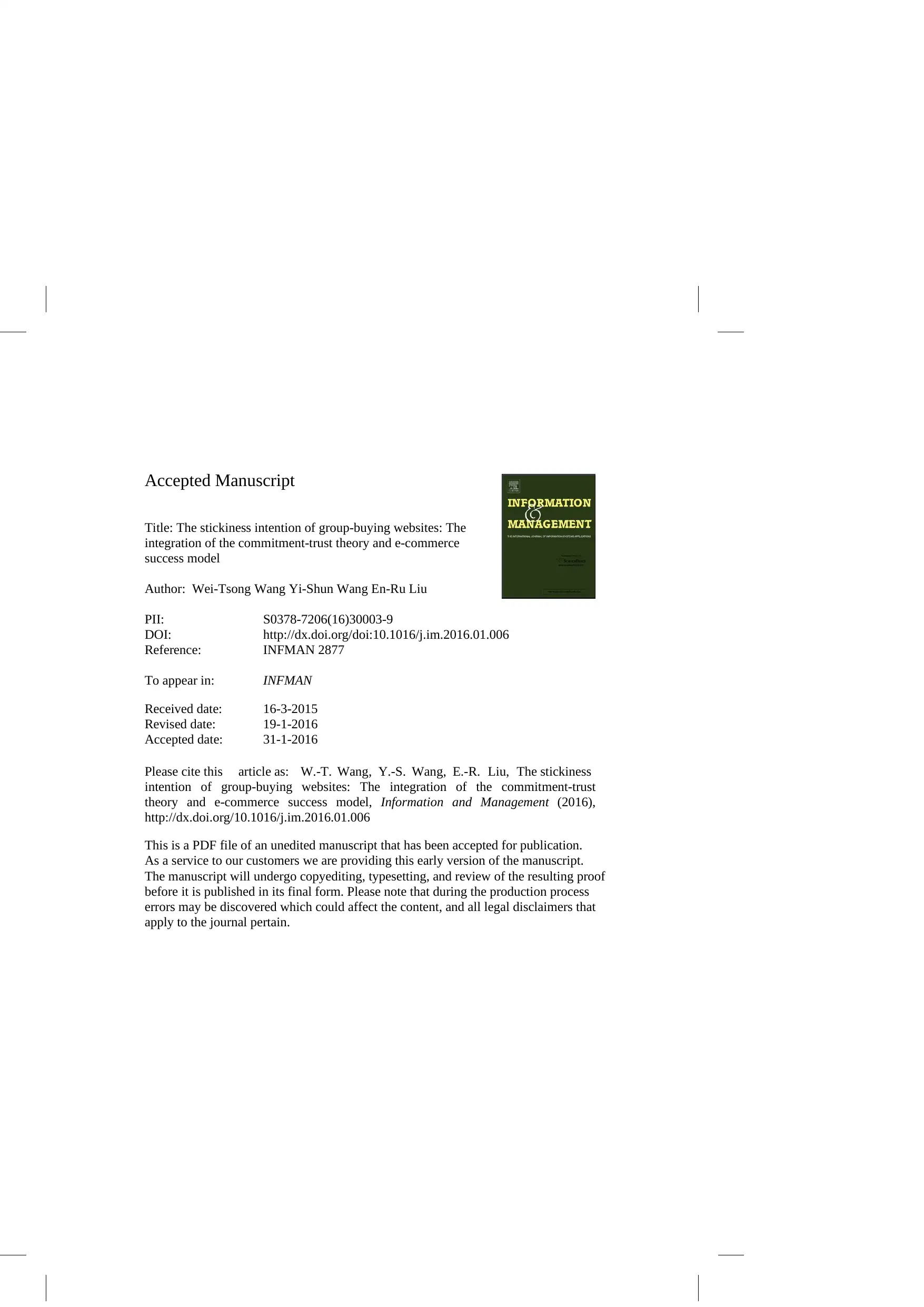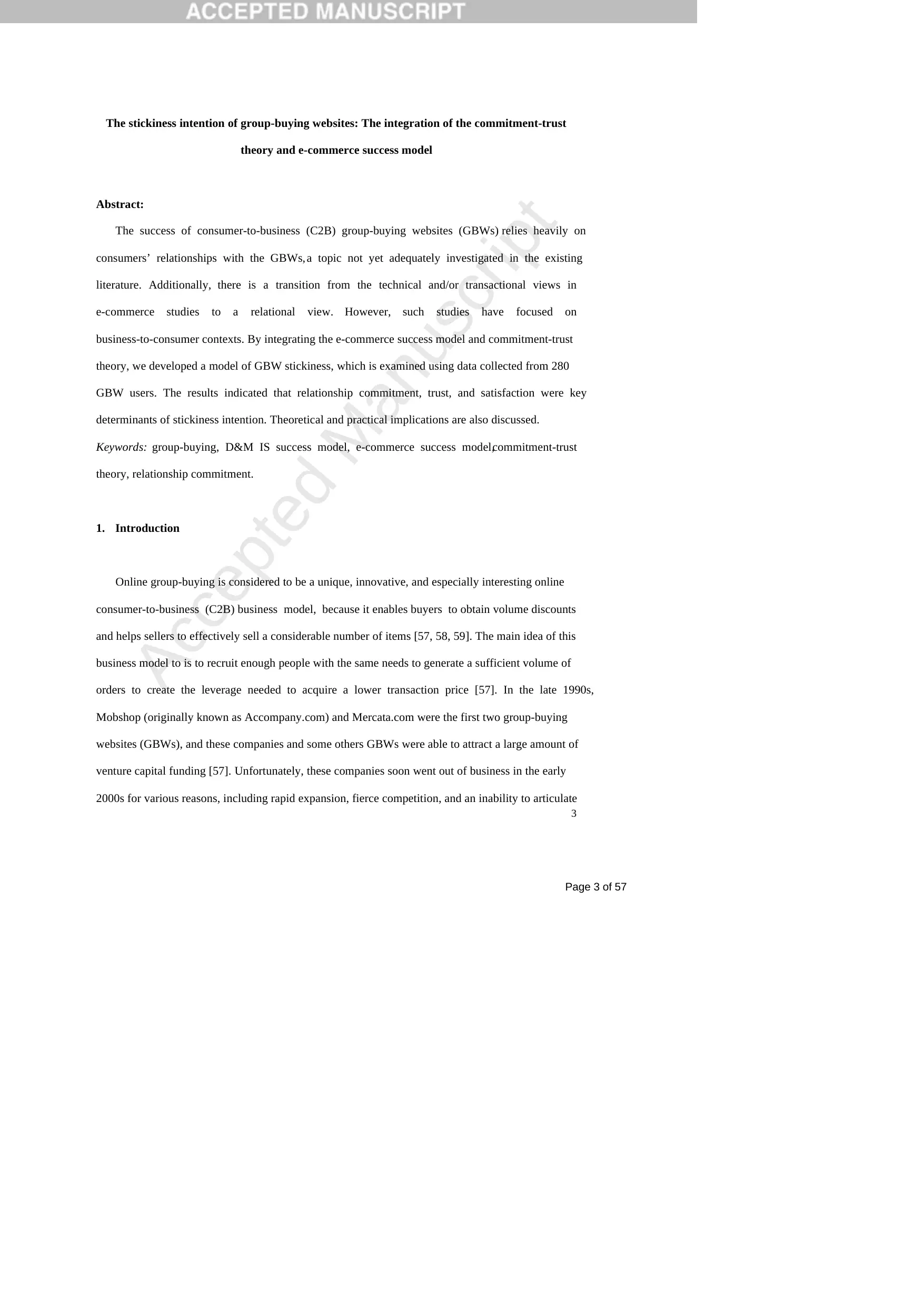Stickiness Intention of Group-Buying Websites: A Theoretical Analysis
VerifiedAdded on 2022/08/25
|58
|22954
|28
Report
AI Summary
This research paper, titled "The stickiness intention of group-buying websites: The integration of the commitment-trust theory and e-commerce success model," investigates the factors that influence consumers' intention to continue using group-buying websites (GBWs). The study integrates the commitment-trust theory and the e-commerce success model to understand the relational aspects of consumer behavior in the context of C2B e-commerce. The authors, Wei-Tsong Wang, Yi-Shun Wang, and En-Ru Liu, examine how relationship commitment, trust, and satisfaction impact GBW stickiness. The paper highlights the transition from technical and transactional views to a relational view in e-commerce studies, emphasizing the importance of social and psychological factors. The research, based on data from 280 GBW users, identifies key determinants of stickiness intention and discusses both theoretical and practical implications for GBW managers. The study aims to address the research question: What factors affect online consumers’ intention to stick with a specific GBW for participating in online group-buying activities? The study contributes to the existing literature by providing integrated theoretical insights, validating the e-commerce success model in the online group-buying context, and extending the applicability of the commitment-trust theory. The paper also provides a comprehensive overview of online group-buying, its evolution, and the challenges GBWs face in retaining customers, emphasizing the role of risk and trust in online transactions.

Accepted Manuscript
Title: The stickiness intention of group-buying websites: The
integration of the commitment-trust theory and e-commerce
success model
Author: Wei-Tsong Wang Yi-Shun Wang En-Ru Liu
PII: S0378-7206(16)30003-9
DOI: http://dx.doi.org/doi:10.1016/j.im.2016.01.006
Reference: INFMAN 2877
To appear in: INFMAN
Received date: 16-3-2015
Revised date: 19-1-2016
Accepted date: 31-1-2016
Please cite this article as: W.-T. Wang, Y.-S. Wang, E.-R. Liu, The stickiness
intention of group-buying websites: The integration of the commitment-trust
theory and e-commerce success model, Information and Management (2016),
http://dx.doi.org/10.1016/j.im.2016.01.006
This is a PDF file of an unedited manuscript that has been accepted for publication.
As a service to our customers we are providing this early version of the manuscript.
The manuscript will undergo copyediting, typesetting, and review of the resulting proof
before it is published in its final form. Please note that during the production process
errors may be discovered which could affect the content, and all legal disclaimers that
apply to the journal pertain.
Title: The stickiness intention of group-buying websites: The
integration of the commitment-trust theory and e-commerce
success model
Author: Wei-Tsong Wang Yi-Shun Wang En-Ru Liu
PII: S0378-7206(16)30003-9
DOI: http://dx.doi.org/doi:10.1016/j.im.2016.01.006
Reference: INFMAN 2877
To appear in: INFMAN
Received date: 16-3-2015
Revised date: 19-1-2016
Accepted date: 31-1-2016
Please cite this article as: W.-T. Wang, Y.-S. Wang, E.-R. Liu, The stickiness
intention of group-buying websites: The integration of the commitment-trust
theory and e-commerce success model, Information and Management (2016),
http://dx.doi.org/10.1016/j.im.2016.01.006
This is a PDF file of an unedited manuscript that has been accepted for publication.
As a service to our customers we are providing this early version of the manuscript.
The manuscript will undergo copyediting, typesetting, and review of the resulting proof
before it is published in its final form. Please note that during the production process
errors may be discovered which could affect the content, and all legal disclaimers that
apply to the journal pertain.
Paraphrase This Document
Need a fresh take? Get an instant paraphrase of this document with our AI Paraphraser

Page 1 of 57
Accepted Manuscript
1
Title:
The stickiness intention of group-buying websites: The integration of the commitment-trust
theory and e-commerce success model.
Authors:
Wei-Tsong Wang (Corresponding author)
Associate Professor, Department of Industrial and Information Management,
National Cheng Kung University,
1st University Road, Tainan 701, Taiwan;
Tel: +886-6-2757575 ext.53122; Fax: +886-6-2362162
wtwang@mail.ncku.edu.tw
Yi-Shun Wang
Professor, Department of Information Management,
National Changhua University of Education,
No.2, Shi-Da Road, Changhua City 500, Taiwan
Tel: +886-4-7232105 ext.7331; Fax: +886-4-7211162
yswang@cc.ncue.edu.tw
En-Ru Liu
Institute of Industrial and Information Management,
National Cheng Kung University,
1st University Road, Tainan 701, Taiwan
Accepted Manuscript
1
Title:
The stickiness intention of group-buying websites: The integration of the commitment-trust
theory and e-commerce success model.
Authors:
Wei-Tsong Wang (Corresponding author)
Associate Professor, Department of Industrial and Information Management,
National Cheng Kung University,
1st University Road, Tainan 701, Taiwan;
Tel: +886-6-2757575 ext.53122; Fax: +886-6-2362162
wtwang@mail.ncku.edu.tw
Yi-Shun Wang
Professor, Department of Information Management,
National Changhua University of Education,
No.2, Shi-Da Road, Changhua City 500, Taiwan
Tel: +886-4-7232105 ext.7331; Fax: +886-4-7211162
yswang@cc.ncue.edu.tw
En-Ru Liu
Institute of Industrial and Information Management,
National Cheng Kung University,
1st University Road, Tainan 701, Taiwan

Page 2 of 57
Accepted Manuscript
2
Tel: +886-6-2757575 ext.53120-109; Fax: +886-6-2362162
p80511427@gmail.com
ACKNOWLEDGMENTS
The authors thank the Editor and the anonymous reviewers for their valuable feedback
on this paper. The authors also thank the administrators of the online forums and websites
studied for their support and the survey respondents for providing valuable data. This
research was funded by Ministry of Science and Technology, Taiwan [grant number: MOST
103-2410-H-006-043].
Accepted Manuscript
2
Tel: +886-6-2757575 ext.53120-109; Fax: +886-6-2362162
p80511427@gmail.com
ACKNOWLEDGMENTS
The authors thank the Editor and the anonymous reviewers for their valuable feedback
on this paper. The authors also thank the administrators of the online forums and websites
studied for their support and the survey respondents for providing valuable data. This
research was funded by Ministry of Science and Technology, Taiwan [grant number: MOST
103-2410-H-006-043].
⊘ This is a preview!⊘
Do you want full access?
Subscribe today to unlock all pages.

Trusted by 1+ million students worldwide

Page 3 of 57
Accepted Manuscript
3
The stickiness intention of group-buying websites: The integration of the commitment-trust
theory and e-commerce success model
Abstract:
The success of consumer-to-business (C2B) group-buying websites (GBWs) relies heavily on
consumers’ relationships with the GBWs, a topic not yet adequately investigated in the existing
literature. Additionally, there is a transition from the technical and/or transactional views in
e-commerce studies to a relational view. However, such studies have focused on
business-to-consumer contexts. By integrating the e-commerce success model and commitment-trust
theory, we developed a model of GBW stickiness, which is examined using data collected from 280
GBW users. The results indicated that relationship commitment, trust, and satisfaction were key
determinants of stickiness intention. Theoretical and practical implications are also discussed.
Keywords: group-buying, D&M IS success model, e-commerce success model,commitment-trust
theory, relationship commitment.
1. Introduction
Online group-buying is considered to be a unique, innovative, and especially interesting online
consumer-to-business (C2B) business model, because it enables buyers to obtain volume discounts
and helps sellers to effectively sell a considerable number of items [57, 58, 59]. The main idea of this
business model to is to recruit enough people with the same needs to generate a sufficient volume of
orders to create the leverage needed to acquire a lower transaction price [57]. In the late 1990s,
Mobshop (originally known as Accompany.com) and Mercata.com were the first two group-buying
websites (GBWs), and these companies and some others GBWs were able to attract a large amount of
venture capital funding [57]. Unfortunately, these companies soon went out of business in the early
2000s for various reasons, including rapid expansion, fierce competition, and an inability to articulate
Accepted Manuscript
3
The stickiness intention of group-buying websites: The integration of the commitment-trust
theory and e-commerce success model
Abstract:
The success of consumer-to-business (C2B) group-buying websites (GBWs) relies heavily on
consumers’ relationships with the GBWs, a topic not yet adequately investigated in the existing
literature. Additionally, there is a transition from the technical and/or transactional views in
e-commerce studies to a relational view. However, such studies have focused on
business-to-consumer contexts. By integrating the e-commerce success model and commitment-trust
theory, we developed a model of GBW stickiness, which is examined using data collected from 280
GBW users. The results indicated that relationship commitment, trust, and satisfaction were key
determinants of stickiness intention. Theoretical and practical implications are also discussed.
Keywords: group-buying, D&M IS success model, e-commerce success model,commitment-trust
theory, relationship commitment.
1. Introduction
Online group-buying is considered to be a unique, innovative, and especially interesting online
consumer-to-business (C2B) business model, because it enables buyers to obtain volume discounts
and helps sellers to effectively sell a considerable number of items [57, 58, 59]. The main idea of this
business model to is to recruit enough people with the same needs to generate a sufficient volume of
orders to create the leverage needed to acquire a lower transaction price [57]. In the late 1990s,
Mobshop (originally known as Accompany.com) and Mercata.com were the first two group-buying
websites (GBWs), and these companies and some others GBWs were able to attract a large amount of
venture capital funding [57]. Unfortunately, these companies soon went out of business in the early
2000s for various reasons, including rapid expansion, fierce competition, and an inability to articulate
Paraphrase This Document
Need a fresh take? Get an instant paraphrase of this document with our AI Paraphraser

Page 4 of 57
Accepted Manuscript
4
promising revenue models [13]. Surprisingly, group-buying businesses have been trying to make a
comeback in recent years [58], and the number of GBWs is rapidly increasing around the globe,
particularly in East Asia [57]. Recent statistics indicate that by 2015, revenue for the online
group-buying market will reach 4.17 billion dollars in the United States. Managers of many
commercial websites have put efforts into developing their own group-buying business models by
providing group-buying functions on their websites (such as Yahoo!) or by merging with foreign
group-buying websites to pursue foreign markets (such as Groupon’s merger with Atlaspost.com to
enter the Asian online group-buying market) [16]. These developments suggestthat although this
business model has not yet proven to be a long-term success, it appears to have a bright future.
However, as the size of the online group-buying market continues to grow, the accompanying
competition has made it increasingly difficult for GBWs to retain their customers [16]. Some statistics
indicate that in the first quarter of 2012, more than 70% (approximately 4,000) of the GBWs in China
went out of business or switched to other online business models because of consumer dissatisfaction
and difficulties in building consumer loyalty. Online group-buying activities tend to face risk- and
trust-related issues that significantly affect online consumers’ participation intention to and that are
not present in other online retailing mechanisms [58]. For example, compared to other online
transaction mechanisms, consumers of online group-buying activities are more uncertain about the
final purchasing price or whether the group-buying initiatives will succeed, because an insufficient
number of group-buying participants may lead to a relatively higher purchasing price or even a failed
group-buying initiative. Participants may also suffer from financial losses because of the
incompetence of the online group-buying intermediaries in preventing deceitful behaviors.
Consequently, the risk and trust issues related to online group-buying deserve close examination from
a relational perspective.
Despite the practical relevance outlined above, the findings of the extent information system (IS)
literature are insufficient in terms of offering a holistic theoretical ground for understanding consumer
intentions regarding the use of GBWs. While electronic commerce (e-commerce) professionals find it
Accepted Manuscript
4
promising revenue models [13]. Surprisingly, group-buying businesses have been trying to make a
comeback in recent years [58], and the number of GBWs is rapidly increasing around the globe,
particularly in East Asia [57]. Recent statistics indicate that by 2015, revenue for the online
group-buying market will reach 4.17 billion dollars in the United States. Managers of many
commercial websites have put efforts into developing their own group-buying business models by
providing group-buying functions on their websites (such as Yahoo!) or by merging with foreign
group-buying websites to pursue foreign markets (such as Groupon’s merger with Atlaspost.com to
enter the Asian online group-buying market) [16]. These developments suggestthat although this
business model has not yet proven to be a long-term success, it appears to have a bright future.
However, as the size of the online group-buying market continues to grow, the accompanying
competition has made it increasingly difficult for GBWs to retain their customers [16]. Some statistics
indicate that in the first quarter of 2012, more than 70% (approximately 4,000) of the GBWs in China
went out of business or switched to other online business models because of consumer dissatisfaction
and difficulties in building consumer loyalty. Online group-buying activities tend to face risk- and
trust-related issues that significantly affect online consumers’ participation intention to and that are
not present in other online retailing mechanisms [58]. For example, compared to other online
transaction mechanisms, consumers of online group-buying activities are more uncertain about the
final purchasing price or whether the group-buying initiatives will succeed, because an insufficient
number of group-buying participants may lead to a relatively higher purchasing price or even a failed
group-buying initiative. Participants may also suffer from financial losses because of the
incompetence of the online group-buying intermediaries in preventing deceitful behaviors.
Consequently, the risk and trust issues related to online group-buying deserve close examination from
a relational perspective.
Despite the practical relevance outlined above, the findings of the extent information system (IS)
literature are insufficient in terms of offering a holistic theoretical ground for understanding consumer
intentions regarding the use of GBWs. While electronic commerce (e-commerce) professionals find it

Page 5 of 57
Accepted Manuscript
5
increasingly difficult to motivate online consumers to stick to a specific website, significant efforts
have been made to evaluate the success of e-commerce websites from technical/IS and/or
transactional perspectives [80, 109, 117]. The technical/IS view, which is also referred to as the
socio-technical view, presumes that issues related to the user adoption of IS/websites are to be
investigated by primarily considering how the design and use of IS/websites can fit with
organizational objectives by being an integral part of organizational communication, cooperation, and
operational arrangement mechanisms (i.e., the social/organizational role of IS)[50]. Additionally,
Petter et al. [94] indicate that considerations related to consumer benefits (i.e., the transactional view)
and consumer use of e-commerce systems (i.e., the technical view) are essential in assessing the
success of IS in various contexts.
However, in addition to the technical perspective, there has been a transition from a transactional
view, which emphasizes the post-purchase satisfaction paradigm, to a relational view, which
emphasizes the importance of social and psychological factors (e.g., trust and commitment), in
studies of the interactions between online consumers and e-commerce websites [72]. Satisfaction
alone may not always guarantee repatronage or the continued use of an e-commerce website [57, 93].
When consumers have convenient access to alternative online vendors that have features that are
similar to or indistinguishable from their original online vendors, satisfaction may not be enough to
prevent these consumers from switching to these alternatives [72]. Consequently, the formation of a
relational bond is critical to discouraging the switching behaviors of online consumers [16].
Additionally, Zhou et al. [119] argue that satisfaction (i.e., a transactional factor) is backward-looking
and more transitory than commitment, and reflects a response to day-to-day events and contextual
changes. In contrast, commitment (i.e., a relational factor) is forward-looking and more enduring over
time in influencing individuals’ behavioral intentions, free from the influences of short-term changes
in situational elements. To sum up, while the transactional view focuses on the one-time provision of
various benefits and favorable experiences to online consumers during the interactions they have with
e-vendors/websites, the relational view primarily emphasizes the development and maintenance of
Accepted Manuscript
5
increasingly difficult to motivate online consumers to stick to a specific website, significant efforts
have been made to evaluate the success of e-commerce websites from technical/IS and/or
transactional perspectives [80, 109, 117]. The technical/IS view, which is also referred to as the
socio-technical view, presumes that issues related to the user adoption of IS/websites are to be
investigated by primarily considering how the design and use of IS/websites can fit with
organizational objectives by being an integral part of organizational communication, cooperation, and
operational arrangement mechanisms (i.e., the social/organizational role of IS)[50]. Additionally,
Petter et al. [94] indicate that considerations related to consumer benefits (i.e., the transactional view)
and consumer use of e-commerce systems (i.e., the technical view) are essential in assessing the
success of IS in various contexts.
However, in addition to the technical perspective, there has been a transition from a transactional
view, which emphasizes the post-purchase satisfaction paradigm, to a relational view, which
emphasizes the importance of social and psychological factors (e.g., trust and commitment), in
studies of the interactions between online consumers and e-commerce websites [72]. Satisfaction
alone may not always guarantee repatronage or the continued use of an e-commerce website [57, 93].
When consumers have convenient access to alternative online vendors that have features that are
similar to or indistinguishable from their original online vendors, satisfaction may not be enough to
prevent these consumers from switching to these alternatives [72]. Consequently, the formation of a
relational bond is critical to discouraging the switching behaviors of online consumers [16].
Additionally, Zhou et al. [119] argue that satisfaction (i.e., a transactional factor) is backward-looking
and more transitory than commitment, and reflects a response to day-to-day events and contextual
changes. In contrast, commitment (i.e., a relational factor) is forward-looking and more enduring over
time in influencing individuals’ behavioral intentions, free from the influences of short-term changes
in situational elements. To sum up, while the transactional view focuses on the one-time provision of
various benefits and favorable experiences to online consumers during the interactions they have with
e-vendors/websites, the relational view primarily emphasizes the development and maintenance of
⊘ This is a preview!⊘
Do you want full access?
Subscribe today to unlock all pages.

Trusted by 1+ million students worldwide

Page 6 of 57
Accepted Manuscript
6
sustainable and favorable relationships between online consumers and e-vendors/websites through
personalized social and psychological exchanges [72, 102].
Commitment-trust theory [86] enables researchers to consider the formation and the effects of
the relational bond between two exchange parties by proposing relationship commitment and trust as
key factors that influence the consumers’ attitudes toward a particular business. Commitment-trust
theory has drawn the attention of e-commerce researchers [53, 72, 87, 106]. However, e-commerce
studies that adopt the relational view primarily focus on business-to-consumer (B2C) or
business-to-business (B2B) contexts and emphasize the effects of trust on consumer behaviors [2, 62,
103]. Very few of these studies focus on C2B contexts, such as consumer-initiated online
group-buying transactions [16, 63, 104], particularly from the perspective of relationship
commitments among the various parties. Consequently, the interesting and important issue of why
some GBWs fail while others survive deserves to be investigated by specific research efforts using
theoretical analysis [15]. With that motivation, this study aims to address the following research
question (RQ):
RQ: What factors affect online consumers’ intention to stick with a specific GBW for participating in
online group-buying activities?
To answer this question, the primary purposes of this study are thus twofold. First, the transition
from the technical and/or transactional views to a relational view indicates that the key to the success
of e-commerce websites lies not only in customer satisfaction, but also in the relational attachments
of online customers to these websites. Consequently,this study develops a theoretical model to
evaluate the success of e-commerce websites by integrating the technical, transactional, and relational
views using the commitment-trust theory [86] and e-commerce success model [109] as the theoretical
basis. In addition to the emphasis on the importance of relationship commitment and trust in
predicting volitional user behavior of online services,the proposed set of antecedents (e.g., cost-,
benefits-, and value-related factors) of commitment-trust theory implicitly incorporate the notion of
the transactional view. This makes the commitment-trust theory an appropriate theory that
Accepted Manuscript
6
sustainable and favorable relationships between online consumers and e-vendors/websites through
personalized social and psychological exchanges [72, 102].
Commitment-trust theory [86] enables researchers to consider the formation and the effects of
the relational bond between two exchange parties by proposing relationship commitment and trust as
key factors that influence the consumers’ attitudes toward a particular business. Commitment-trust
theory has drawn the attention of e-commerce researchers [53, 72, 87, 106]. However, e-commerce
studies that adopt the relational view primarily focus on business-to-consumer (B2C) or
business-to-business (B2B) contexts and emphasize the effects of trust on consumer behaviors [2, 62,
103]. Very few of these studies focus on C2B contexts, such as consumer-initiated online
group-buying transactions [16, 63, 104], particularly from the perspective of relationship
commitments among the various parties. Consequently, the interesting and important issue of why
some GBWs fail while others survive deserves to be investigated by specific research efforts using
theoretical analysis [15]. With that motivation, this study aims to address the following research
question (RQ):
RQ: What factors affect online consumers’ intention to stick with a specific GBW for participating in
online group-buying activities?
To answer this question, the primary purposes of this study are thus twofold. First, the transition
from the technical and/or transactional views to a relational view indicates that the key to the success
of e-commerce websites lies not only in customer satisfaction, but also in the relational attachments
of online customers to these websites. Consequently,this study develops a theoretical model to
evaluate the success of e-commerce websites by integrating the technical, transactional, and relational
views using the commitment-trust theory [86] and e-commerce success model [109] as the theoretical
basis. In addition to the emphasis on the importance of relationship commitment and trust in
predicting volitional user behavior of online services,the proposed set of antecedents (e.g., cost-,
benefits-, and value-related factors) of commitment-trust theory implicitly incorporate the notion of
the transactional view. This makes the commitment-trust theory an appropriate theory that
Paraphrase This Document
Need a fresh take? Get an instant paraphrase of this document with our AI Paraphraser

Page 7 of 57
Accepted Manuscript
7
complements the transactional view from a relational marketing perspective. Additionally, the
e-commerce success model, by integrating the technical/IS and transactional views, depicts
individuals’ perceptions regarding their interactions with the IS/websites, which resemble their
evaluation of their relationships with the IS/websites. This feature makes the e-commerce success
model an important theoretical base for this study in terms of integrating the technical, transactional,
and relational views by complementing the insufficiency of the commitment-trust theory in terms of
capturing the antecedents of commitment and trust that are associated with online business contexts.
Second, relatively few studies have empirically examined issues related to customer retention in
online C2B contexts. Consequently, this study empirically examines the proposed model in the
context of online group-buying activities via GBWs.
This study contributes to both the emerging online group-buying literature and general
e-commerce literature in a number of ways. First, to the best of our knowledge, this study is among
the first to provide an integrated theoretical insights into understanding online consumers’ stickiness
intention regarding GBWs by incorporating antecedent and intervening factors that are critical to the
online group-buying context from technical, transactional, and relational perspectives. Second, while
the e-commerce success model has been frequently applied to studies of post-purchase adoption in
various e-commerce contexts [20, 105, 109], our findings contribute to this model by adopting and
validating it in the online group-buying (C2B) context. Finally, although the commitment-trust theory
has been partially applied to e-commerce studies [62, 72, 87, 103, 106], this study applied it to
simultaneously investigate the effects of relationship commitment and trust on consumers’ intention
regarding the use of GBWs, thus extending its applicability.
2. Theoretical Background
2.1 Online group-buying
The core concept of online group-buying is that gathering a group of consumers with the same
Accepted Manuscript
7
complements the transactional view from a relational marketing perspective. Additionally, the
e-commerce success model, by integrating the technical/IS and transactional views, depicts
individuals’ perceptions regarding their interactions with the IS/websites, which resemble their
evaluation of their relationships with the IS/websites. This feature makes the e-commerce success
model an important theoretical base for this study in terms of integrating the technical, transactional,
and relational views by complementing the insufficiency of the commitment-trust theory in terms of
capturing the antecedents of commitment and trust that are associated with online business contexts.
Second, relatively few studies have empirically examined issues related to customer retention in
online C2B contexts. Consequently, this study empirically examines the proposed model in the
context of online group-buying activities via GBWs.
This study contributes to both the emerging online group-buying literature and general
e-commerce literature in a number of ways. First, to the best of our knowledge, this study is among
the first to provide an integrated theoretical insights into understanding online consumers’ stickiness
intention regarding GBWs by incorporating antecedent and intervening factors that are critical to the
online group-buying context from technical, transactional, and relational perspectives. Second, while
the e-commerce success model has been frequently applied to studies of post-purchase adoption in
various e-commerce contexts [20, 105, 109], our findings contribute to this model by adopting and
validating it in the online group-buying (C2B) context. Finally, although the commitment-trust theory
has been partially applied to e-commerce studies [62, 72, 87, 103, 106], this study applied it to
simultaneously investigate the effects of relationship commitment and trust on consumers’ intention
regarding the use of GBWs, thus extending its applicability.
2. Theoretical Background
2.1 Online group-buying
The core concept of online group-buying is that gathering a group of consumers with the same

Page 8 of 57
Accepted Manuscript
8
needs and then leveraging their collective bargaining power to lower the prices for the products or
services of interest [57]. The bargaining power thus grows with the number of consumers in a group.
Demand aggregation and volume discounting are thus key features of this business model [3]. The
primary value proposition of online group-buying to consumers is making a deal at a lower price by
connecting and uniting individuals who share the same needs on certain products/services in a
specific timeframe via the Internet to use their collective bargaining power to negotiate with the
sellers, and thus get volume discounts that were traditionally the privilege of bulk buyers [60, 78].
Additionally, sellers who participate in group-buying activities can be benefited by creating leverage
to reduce the cost of acquiring customers, which makes it possible to create a win-win situations for
both buyers and sellers [57].
Although the online group-buying model has been used in B2B contexts, its primary use is in the
purchase activities of end consumers, and the process is mostly accomplished via online
intermediaries. Online group-buying opportunities can either be marketer-initiated transactions, which
include merchant-initiated transactions and independent-third-party-initiated transactions, or
consumer-initiated transactions [16, 58, 63]. Consumer-initiated transactions are the most popular
forms of online group-buying, and this type of transaction is considered to represent a C2B business
model [13, 14]. In a consumer-initiated transaction, a consumer (i.e., the initiator), as the
representative of a group of consumers with the same needs, must actively negotiate with multiple
sellers for a discounted price on the product of interest, which is similar to asking sellers to bid on a
product for a group of potential buyers. Quantity discount is the major motivation of this
group-buying activity, and the pricing of this quantity order may either be a proposal sent by sellers or
the results of the negotiation process between the initiator and the sellers [13]. In this process, the
initiator may continue to put efforts into recruiting more consumers to join this shopping group, via
the use of online intermediaries, to meet the quantity requirement of a particular seller that is offering
the most favorable quantity discount. Eventually, if the quantity requirement is met before a specified
deadline, the shopping group closes the deal with this particular seller and a group-buying transaction
Accepted Manuscript
8
needs and then leveraging their collective bargaining power to lower the prices for the products or
services of interest [57]. The bargaining power thus grows with the number of consumers in a group.
Demand aggregation and volume discounting are thus key features of this business model [3]. The
primary value proposition of online group-buying to consumers is making a deal at a lower price by
connecting and uniting individuals who share the same needs on certain products/services in a
specific timeframe via the Internet to use their collective bargaining power to negotiate with the
sellers, and thus get volume discounts that were traditionally the privilege of bulk buyers [60, 78].
Additionally, sellers who participate in group-buying activities can be benefited by creating leverage
to reduce the cost of acquiring customers, which makes it possible to create a win-win situations for
both buyers and sellers [57].
Although the online group-buying model has been used in B2B contexts, its primary use is in the
purchase activities of end consumers, and the process is mostly accomplished via online
intermediaries. Online group-buying opportunities can either be marketer-initiated transactions, which
include merchant-initiated transactions and independent-third-party-initiated transactions, or
consumer-initiated transactions [16, 58, 63]. Consumer-initiated transactions are the most popular
forms of online group-buying, and this type of transaction is considered to represent a C2B business
model [13, 14]. In a consumer-initiated transaction, a consumer (i.e., the initiator), as the
representative of a group of consumers with the same needs, must actively negotiate with multiple
sellers for a discounted price on the product of interest, which is similar to asking sellers to bid on a
product for a group of potential buyers. Quantity discount is the major motivation of this
group-buying activity, and the pricing of this quantity order may either be a proposal sent by sellers or
the results of the negotiation process between the initiator and the sellers [13]. In this process, the
initiator may continue to put efforts into recruiting more consumers to join this shopping group, via
the use of online intermediaries, to meet the quantity requirement of a particular seller that is offering
the most favorable quantity discount. Eventually, if the quantity requirement is met before a specified
deadline, the shopping group closes the deal with this particular seller and a group-buying transaction
⊘ This is a preview!⊘
Do you want full access?
Subscribe today to unlock all pages.

Trusted by 1+ million students worldwide

Page 9 of 57
Accepted Manuscript
9
is completed. This study focuses on consumer-initiated group-buying transactions.
The online group-buying mechanism is different from that of the traditional quantity discounts for
two main reasons [15, 58, 78]. One is that in a traditional quantity discount situation the seller sets its
own optimal discount quantity and price, while in a group-buying context the price is determined
based on the total quantity of the product/service that all the participating buyers want to buy. The
other is related to the special dynamics of the online group-buying model. In a traditional quantity
discount situation, individual buyers place their own orders based on the information provided by the
seller. However, in a group-buying context in which price is dynamic and uncertain (depending on the
collective bargaining power of the buyer group at the deadline of the group-buying activity), one
buyer’s order would affect the other buyers’ benefits from their participation of the group-buying
activity. Therefore, on many occasions potential buyers may not participate in an online group-buying
activity unless they see evidence that other buyers are participating enthusiastically, and that the
quantity discount threshold they desire is highly likely to be reached.
Online group-buying behaviors are also different from those of group bargaining or negotiations.
For example, negotiations among groups of companies tend to involve multifaceted issues, and thus
different negotiation strategies and decision rules may be applied based on the situations [8].
Additionally, individual members of a group may join the group for diverse motivations,and thus
integrative agreements that can maximize the joint benefits of the individual members in a group may
be mostly elusive [8]. Moreover, consumer groups that are formed on group-buying websites are
relatively unstable compared to traditional social or consumer cooperatives [63]. Consumers’ lack of
access and time to repeatedly interact with one another to develop personal relationships or a group
identity may contribute to the instability of these consumer groups. Thus, relying primarily on
group-related factors that apply to groups in online communities/social networking websites, such as
sense of belonging and group identity, may not be effective enough to help GBWs retain their
consumers. It is thus important for GBWs to develop relationships with individual consumers.
Additionally, consumers who participate in online group-buying activities tend to seek positive
Accepted Manuscript
9
is completed. This study focuses on consumer-initiated group-buying transactions.
The online group-buying mechanism is different from that of the traditional quantity discounts for
two main reasons [15, 58, 78]. One is that in a traditional quantity discount situation the seller sets its
own optimal discount quantity and price, while in a group-buying context the price is determined
based on the total quantity of the product/service that all the participating buyers want to buy. The
other is related to the special dynamics of the online group-buying model. In a traditional quantity
discount situation, individual buyers place their own orders based on the information provided by the
seller. However, in a group-buying context in which price is dynamic and uncertain (depending on the
collective bargaining power of the buyer group at the deadline of the group-buying activity), one
buyer’s order would affect the other buyers’ benefits from their participation of the group-buying
activity. Therefore, on many occasions potential buyers may not participate in an online group-buying
activity unless they see evidence that other buyers are participating enthusiastically, and that the
quantity discount threshold they desire is highly likely to be reached.
Online group-buying behaviors are also different from those of group bargaining or negotiations.
For example, negotiations among groups of companies tend to involve multifaceted issues, and thus
different negotiation strategies and decision rules may be applied based on the situations [8].
Additionally, individual members of a group may join the group for diverse motivations,and thus
integrative agreements that can maximize the joint benefits of the individual members in a group may
be mostly elusive [8]. Moreover, consumer groups that are formed on group-buying websites are
relatively unstable compared to traditional social or consumer cooperatives [63]. Consumers’ lack of
access and time to repeatedly interact with one another to develop personal relationships or a group
identity may contribute to the instability of these consumer groups. Thus, relying primarily on
group-related factors that apply to groups in online communities/social networking websites, such as
sense of belonging and group identity, may not be effective enough to help GBWs retain their
consumers. It is thus important for GBWs to develop relationships with individual consumers.
Additionally, consumers who participate in online group-buying activities tend to seek positive
Paraphrase This Document
Need a fresh take? Get an instant paraphrase of this document with our AI Paraphraser

Page 10 of 57
Accepted Manuscript
10
relationships with sellers, intermediary websites, and other consumers to reduce the uncertainties and
risks associated with online group-buying activities [58].
The social psychology literature suggests that frequent, favorable interpersonal interactions help
to reduce uncertainty and increase trust in others in a social context, and thus promote the emergence
of groups (i.e., social structures) [114]. Additionally, research finds that reciprocal exchanges tend to
enable and increase trust in others members of a group, and thus result in strong ties/relational bonds
among group members [85]. Different forms and levels of uncertainty may exist in different exchange
conditions, and thus may lead to different relationships and social structures among stakeholders in
the exchanges [64]. The arguments above indicate the need to specifically examine the effects of the
relationships among stakeholders in an online group-buying context on the use of the GBWs.In
summary, online group-buying is considered a unique online transaction method that deserves to be
investigated in its own right with regard to key success factors.
Most of the existing empirical studies of user behaviors of GBWs take a multi-perspective
approach for conceptualizing and explaining the use of GBWs, as summarized in Appendix A.
Despite the contributions of these previous studies, most of them do not investigate the users’
intention to use GBWs by simultaneously adoptions the technical, transactional, and relational
perspectives, except for the works of Lang et al. [68] and Yeh et al. [116]. However, the contribution
of those two studies are limited, because they neither incorporate the key factors of the three indicated
conceptual perspectives (e.g., system-related quality factors, satisfaction, and relationship
commitment) nor provide a reasonable nomological structure for explaining the interactions and
relationships between the key technical, transactional, and relational factors that they adopt for
comprehending GBW users’ intentions. Additionally, although some of these prior studies adopt the
incorporate some relational factors for investigating the use of GBWs, they are inadequate to offer
nuanced insights into users’ stickiness intention with GBWs from a relational perspective for two
reasons. One is that while some of those studies highlight the importance of investigating the use of
GBWs from a relational perspective, they primarily focus on how the relationships among members
Accepted Manuscript
10
relationships with sellers, intermediary websites, and other consumers to reduce the uncertainties and
risks associated with online group-buying activities [58].
The social psychology literature suggests that frequent, favorable interpersonal interactions help
to reduce uncertainty and increase trust in others in a social context, and thus promote the emergence
of groups (i.e., social structures) [114]. Additionally, research finds that reciprocal exchanges tend to
enable and increase trust in others members of a group, and thus result in strong ties/relational bonds
among group members [85]. Different forms and levels of uncertainty may exist in different exchange
conditions, and thus may lead to different relationships and social structures among stakeholders in
the exchanges [64]. The arguments above indicate the need to specifically examine the effects of the
relationships among stakeholders in an online group-buying context on the use of the GBWs.In
summary, online group-buying is considered a unique online transaction method that deserves to be
investigated in its own right with regard to key success factors.
Most of the existing empirical studies of user behaviors of GBWs take a multi-perspective
approach for conceptualizing and explaining the use of GBWs, as summarized in Appendix A.
Despite the contributions of these previous studies, most of them do not investigate the users’
intention to use GBWs by simultaneously adoptions the technical, transactional, and relational
perspectives, except for the works of Lang et al. [68] and Yeh et al. [116]. However, the contribution
of those two studies are limited, because they neither incorporate the key factors of the three indicated
conceptual perspectives (e.g., system-related quality factors, satisfaction, and relationship
commitment) nor provide a reasonable nomological structure for explaining the interactions and
relationships between the key technical, transactional, and relational factors that they adopt for
comprehending GBW users’ intentions. Additionally, although some of these prior studies adopt the
incorporate some relational factors for investigating the use of GBWs, they are inadequate to offer
nuanced insights into users’ stickiness intention with GBWs from a relational perspective for two
reasons. One is that while some of those studies highlight the importance of investigating the use of
GBWs from a relational perspective, they primarily focus on how the relationships among members

Page 11 of 57
Accepted Manuscript
11
of the buyers’ groups may influence their behaviors regarding the use of GBWs. The influence of the
relationships between online consumers and GBWs on the consumers’ intentions regarding the use of
GBWs remains an under-researched topic. The other is that research indicates that relationship
commitment and trust are vital for differentiating relational exchanges from pure economic exchanges,
and are thus considered to be critical factors for determining pro-relationship behaviors and
motivations [72, 86]. While a number of previous studies have leveraged the relational view to
investigate consumers’ adoption/post-adoption behavior with respect to GBWs, they comprehend the
building and development of such relationships as the consequence of interpersonal trust and various
forms of social influences. The important role of relationship commitment is unfortunately
overlooked, resulting in a conceptual gap in the current understanding of why online consumers stick
with a GBW given the fact that the use of GBWs are not as indispensable to today’s online users as
other types of websites, such as online portals [119].
2.2 E-commerce success model
DeLone and McLean’s [26, 27, 28] original and updated Information Systems Success models
(D&M ISS models) are among the most widely used for evaluating the degree of IS success because
of their comprehensiveness. The original D&M ISS model includes six dimensions: system quality,
information quality, user satisfaction, system use, individual impact, and organizational impact [26].
To meet the needs of academic assessments of IS success in response to changes in the role of such
systems, DeLone and McLean [27] proposed an updated D&M ISS model. This updated model
differs from the original in three ways: it adds a new dimension of service quality to the original
dimensions of system quality and information quality to more comprehensively evaluate the overall
quality of information systems; it includes the dimension of intention to use as an alternative to
system use in the contexts of non-mandatory system use (i.e. e-commerce); and it groups all the
impact measures (i.e., individual and organizational impacts) into a single impact/benefit dimension
called net benefit.
Accepted Manuscript
11
of the buyers’ groups may influence their behaviors regarding the use of GBWs. The influence of the
relationships between online consumers and GBWs on the consumers’ intentions regarding the use of
GBWs remains an under-researched topic. The other is that research indicates that relationship
commitment and trust are vital for differentiating relational exchanges from pure economic exchanges,
and are thus considered to be critical factors for determining pro-relationship behaviors and
motivations [72, 86]. While a number of previous studies have leveraged the relational view to
investigate consumers’ adoption/post-adoption behavior with respect to GBWs, they comprehend the
building and development of such relationships as the consequence of interpersonal trust and various
forms of social influences. The important role of relationship commitment is unfortunately
overlooked, resulting in a conceptual gap in the current understanding of why online consumers stick
with a GBW given the fact that the use of GBWs are not as indispensable to today’s online users as
other types of websites, such as online portals [119].
2.2 E-commerce success model
DeLone and McLean’s [26, 27, 28] original and updated Information Systems Success models
(D&M ISS models) are among the most widely used for evaluating the degree of IS success because
of their comprehensiveness. The original D&M ISS model includes six dimensions: system quality,
information quality, user satisfaction, system use, individual impact, and organizational impact [26].
To meet the needs of academic assessments of IS success in response to changes in the role of such
systems, DeLone and McLean [27] proposed an updated D&M ISS model. This updated model
differs from the original in three ways: it adds a new dimension of service quality to the original
dimensions of system quality and information quality to more comprehensively evaluate the overall
quality of information systems; it includes the dimension of intention to use as an alternative to
system use in the contexts of non-mandatory system use (i.e. e-commerce); and it groups all the
impact measures (i.e., individual and organizational impacts) into a single impact/benefit dimension
called net benefit.
⊘ This is a preview!⊘
Do you want full access?
Subscribe today to unlock all pages.

Trusted by 1+ million students worldwide
1 out of 58
Your All-in-One AI-Powered Toolkit for Academic Success.
+13062052269
info@desklib.com
Available 24*7 on WhatsApp / Email
![[object Object]](/_next/static/media/star-bottom.7253800d.svg)
Unlock your academic potential
Copyright © 2020–2025 A2Z Services. All Rights Reserved. Developed and managed by ZUCOL.
